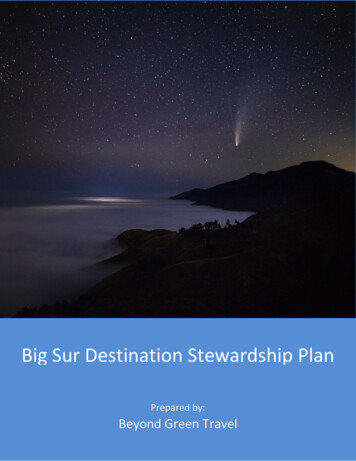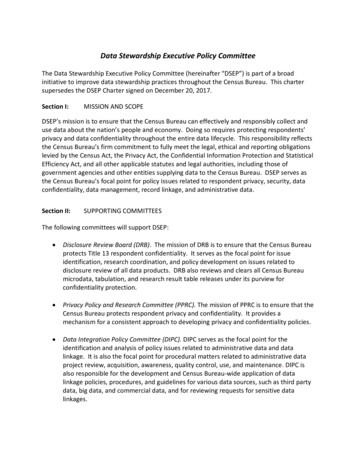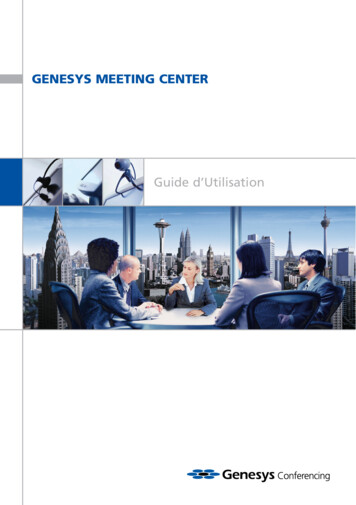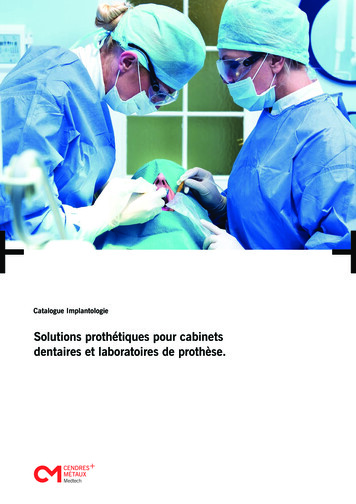
Transcription
Big Sur Destination Stewardship PlanPrepared by:Beyond Green Travel
Cover Photo: Comet Neowise streaks across Big Sur Skies in July 2020By Kodiak Greenwood PhotographyTable of ContentsAcknowledgements. 2Abbreviations . 5Executive Summary. 6About Beyond Green Travel . 14Introduction . 15DSP Vision and Methodology . 22History of Tourism in Big Sur . 24Big Sur Plans: A Legacy to Build On . 31Big Sur Stakeholder Priorities and Survey Results. 44The Path Forward: DSP Recommendations . 54Funding for Implementing Solutions .56Accurate Visitor Management Data .65Visitor Traffic Management .69Rethinking Bixby Bridge and Other Popular Visitation Areas .81Public Restroom Availability .88Addressing Trash and Litter Problems .93Back Country and Front Country Visitation Management .96Visitor Education and Communication . 103Available Community Housing . 109Timeline for Implementation . 113Conclusion . 117References . 119Big Sur Sustainable Tourism DSP, p. 1
AcknowledgementsIt is with respect that this plan acknowledges the Big Sur Coast as beingthe ancestral home of three groups of Indigenous Peoples, speakers ofthe Salinan, Esselen and Ohlone languages.The Big Sur Sustainable Tourism Destination Stewardship Plan was led and writtenby Beyond Green Travel, a sustainable tourism and destination stewardshipconsulting firm, including Costas Christ, President; Sally Christ, Vice President;Nina Boys, Program Director; and Kate Daniels, Project Consultant.Many individuals throughout Big Sur, including residents and communitymembers, as well as multiple stakeholder agencies and organizations thatare active in the Big Sur Land Use area, contributed their time, energy,thoughts, and wisdom to the Destination Stewardship Plan (DSP) process.These contributions were instrumental in the development of the DSP. Aspecial thank you goes to the DSP Steering Committee, who providedsignificant insights and guidance, including reviewing and strengtheningthe DSP’s recommendations. Members of the DSP Steering Committeeinclude:Carissa Chappellet Lawyer and Board President, Big Sur Health CenterKirk GafillPresident of Big Sur Chamber of Commerceand President/CFO of Nepenthe/Phoenix CorporationLaVerne McLeodAuthor, Community Member and Co-Coordinator of Big Sur Advocatesfor a Green Environment (B-SAGE)Lee OtterStrategic Advisor, Big Sur Land Use PlanMatt HarrisFire Chief, Big Sur FireMike FreedCo-Chair, California Task Force on Destination Stewardshipand Owner, Post Ranch InnRyne LeuzingerBoard Member, Community Association of Big Surand Senior Assistant Librarian, CSUMBYuri AndersonChief of Staff to Supervisor Mary Adams, County of Monterey, District 5Big Sur Sustainable Tourism DSP, p. 2
The DSP was funded in cooperation with the Monterey County Board ofSupervisors and in partnership with the Monterey County Convention & VisitorsBureau and the community of Big Sur. Monterey County Convention & VisitorsBureau also provided reporting oversight during the development of the DSP.Special appreciation goes to the Community Association of Big Sur, whichprovided both additional funding and administrative support to the plan.Additional funding support came from the following individuals and organizations:Bill and Nancy Doolittle, Tim and Jean Weiss, Albert McFarland, Nancy BerryBig Sur Sustainable Tourism DSP, p. 3
Appreciation goes to each of the following individuals who graciously contributedfunding, with the assistance of Monterey County Gives, in support of the DSP:Anneliese AgrenL. Jayme “Jai” AlpertBeth Anderson and Chris HartzJoe and Wendy BurnettCorinne ColenDaniela de Sola and Libby BarnesMartha DiehlEichorn FamilyKenneth EkelundDebra GavlakKenneth Gough and Bridgette DiceJohn Hain and Jennifer AllenRich HamiltonSteven HarperAdrienne HermanAnn HobsonJohn Ittelson and Bobbi KamilAl and Mary Ann JardineMary Kenney and Joe PasquaMary Ellen KleeLisa and Karl KleissnerButch and Patte KronlundHeather Chappellet Lanier andSidney LanierMichael Lighty and Jay FarinaScott and Meredith ManhardDanielle MartinBruce MerchantSteve Moore and Suzanne WorcesterJennifer MorrisJan NealBill and Bette NelsonJaci PappasMargaret PeeblesBarbara RayLinda and Scott RhoadesKeely RichterGaye Russel-BruceBarbara SextonSheila Sheppard and Gaston GeorisKarin Strasser KauffmanBarbara ThornburyCammy and Tim TorgenrudCarlos VasquezEby WoldCameron and Frances Wolfe Jr.Bradley ZeveBig Sur Sustainable Tourism DSP, p. 4
List of MBDestination EFWTTCBeyond Green TravelBig Sur Land Use PlanBig Sur Multi-Agency Advisory CouncilCommunity Association of Big SurCalifornia Department of TransportationCommunity Emergency Response TeamCoast Highway Management PlanCalifornia State University at Monterey BayDestination British ColumbiaDestination Marketing OrganizationBig Sur Sustainable Tourism Destination PlanDay Use AreaGross Domestic ProductGreen Destinations StandardGreen Scheme of Slovenian TourismGlobal Sustainable Tourism CriteriaInteragency Visitor Use Management CouncilLos Padres National ForestLand Use Advisory CommitteeMonterey County Convention and Visitors BureauNon-Governmental OrganizationParks Management CompanySustainable Development GoalSan Luis Obispo CountySustainable Transportation Demand Management PlanThe International Ecotourism SocietyThompson Okanagan Tourism AssociationUnited Nations Conference on Trade and DevelopmentUnited Nations Development ProgramUnited Nations Declaration on the Rights of Indigenous PeoplesUnited Nations World Tourism OrganizationUnited States Tour Operators AssociationUnited States Forest ServiceVisitor Use ManagementWorld Economic ForumWorld Travel and Tourism CouncilBig Sur Sustainable Tourism DSP, p. 5
Executive Summary“To protect and preserve the rugged, scenic, natural beauty of BigSur and its cultural heritage, benefit the local economy, and foster awelcoming and sustainable community for generations to come.”- Big Sur Destination Stewardship Plan Vision StatementIn 1950, there were 25 million international tourist arrivals around the world. Fastforward to 2019, and that number grew to 1.5 billion, with ongoing predictionsthat it will reach 1.8 billion by 2030 (UNWTO, 2020). Despite wars, natural disasters,public health emergencies, terrorist attacks and political instability through thedecades, tourism has maintained its steady rise over time. So, too, has a growingvolume of research and case studies revealing that tourism can be both anopportunity and a threat to the very places where visitors seek to spend theirtime. The difference between what makes it an opportunity or a threat comesdown to whether visitation is carefully planned and managed. That is the mainobjective of the Big Sur Sustainable Tourism Destination Stewardship Plan (DSP),which was commissioned by the Monterey County Convention and VisitorsBureau (MCCVB) and the Community Association of Big Sur (CABS) to managevisitation in Big Sur in order to optimize tourism’s positive benefits and minimizeits negative impacts.The primary role of the DSP is to act as a medium through which Big Surcommunity stakeholders are enabled to successfully address specific challengesrelated to visitation by also leveraging other plans relevant to Big Sur, such as theCoast Highway Management Plan (CHMP) and, most importantly, the Big Sur LandUse Plan (BSLUP). While there is a general belief among stakeholders andcommunity members that some of the visitation challenges facing Big Sur can beaddressed within the BSLUP and CHMP, the DSP multi-stakeholder consultationprocess revealed that a majority believe that a separate management plan isneeded to help advance solutions to some of the most pressing visitation-relatedproblems facing Big Sur.Big Sur Sustainable Tourism DSP, p. 6
At its core, the DSP addresses challenges related to tourism that were identifiedthrough an extensive Big Sur multi-stakeholder process of meetings, interviewsand surveys with Big Sur business owners, community members and residents,county, state, and federal officials, as well as local non-profit organizations andassociations, all with a direct connection to Big Sur. In total, over the span of the12-month DSP process, there were 178 small group and individual consultationmeetings and nine large group stakeholder meetings. In addition, 131 stakeholdercomments were submitted to the DSP website and there were 345 DSP ResidentSurveys submitted, including from the Spanish-speaking community. A clearmajority of the above stakeholders (some 75 percent) indicated their support forthe DSP, with a similar majority indicating that doing nothing (maintaining thestatus quo) is no longer an option for Big Sur. As part of the DSP Resident Survey,for example, 80% of respondents strongly agreed that “Now is the time to planfor Big Sur’s future by taking action to manage visitation and tourism through adestination stewardship plan.”Extensive review and synthesis of other Big Sur plans and reports, in conjunctionwith research into the history of visitation in Big Sur and case studies onsustainable tourism destination stewardship best practices from other parts ofthe USA and around the world, were also conducted.While firm data on the total number of visitors to Big Sur remains elusive (one ofthe recommendations of the DSP is that more systematic and reliable visitationdata be collected specific to Big Sur), the steady increase in tourism to bothCalifornia and to Monterey County has been documented in recent years by VisitCalifornia’s research. (California Travel Impacts, 2020). The challenges of visitation in BigSur are not new; historical documents cite that the first reference to Big Sur beingovercrowded with visitors was in 1908 at Pfeiffer Beach. The BSLUP, published in1986, further noted the need to “Optimize rather than maximize visitor uselevels ” (BSLUP, Section 4.1) The increase in visitors in more recent years has led togrowing recognition of the pressing need to better manage visitation in Big Sur.Big Sur Sustainable Tourism DSP, p. 7
Two-thirds of the way through the DSP process, the global coronavirus pandemicwas declared, leading to a sudden and near-total collapse of the travel andtourism industry worldwide. California was no exception - visitation in the statewas brought to a near standstill during a period of lockdown restrictions and asairline travel plummeted. And yet, as Shelter-In-Place orders began to beloosened and removed, Big Sur’s attractions, including Soberanes Point,Garrapata State Park and Garrapata Beach, Bixby Bridge, Pfeiffer Beach, McWayFalls, and other popular recreation and dispersed camping areas saw a quickresurgence of visitation. It is increasingly clear that Big Sur will continue to be apopular place for visitors, as it has been in the past, continues to be currently, andis likely to remain in the future.With the above in mind, now is the time to rethink and reset tourism for Big Surthrough improved visitation planning, monitoring and management. This planprovides analysis and recommendations to support Big Sur to become a model fordestination stewardship based upon the three key pillars of sustainable tourism: Environmentally-friendly PracticesThis includes efforts to maintain a clean environment free from trash andlitter, with proper disposal of waste; promoting clean energy to reducecarbon emissions; sourcing supplies as locally as possible; eliminating singleuse plastics; and support for tracking and monitoring of environmentalimpacts and establishing benchmarks for improvements. Protection of Natural and Cultural HeritageThis includes biodiversity conservation initiatives and programs, as well ashelping to restore, maintain and protect natural habitat, which also serves asan important way to sequester carbon linked to reducing the negative impactsof climate change. Similarly, support for protecting cultural diversity includespreservation of historic buildings and sites of archeological significance;embracing local cultural vernacular in building design; and supporting livingcultural heritage as it is represented through local artistic expression such asmusic, dance, art, and handicrafts, among others.Big Sur Sustainable Tourism DSP, p. 8
Support for the Economic and Social Well-Being of Local CommunitiesThis includes tourism-related policies, programs and initiatives to benefit thepeople in the local area, including hiring locally according to fair wages,benefits, and non-discrimination policies that meet or exceed legalrequirements; supporting local community-owned businesses to the greatestdegree possible; and ensuring that local communities have direct and equalinput on decision-making related to tourism that will affect their lives.The DSP also aligns with the 17 United Nations Sustainable Development Goals(SDGs), which have been embraced globally as a priority for destinationstewardship.To identify the priority challenges that Big Sur faces, and to propose action-basedsolutions, two questions were kept in mind: Is the problem directly connected tovisitation?; Are the solutions consistent with other key Big Sur plans, in particular,the BSLUP? This framed the overall scope for the DSP.Big Sur faces many challenges, including the impacts of climate change on itsnatural environment, both on land and at sea; infrastructure limitations that arephysical, in terms of Highway 1 as the primary access route into the area, as wellas lack of cell phone service and wi-fi access; the multiple jurisdictions andcomplexities of land management and land use in Big Sur - across Federal, State,County agencies; private, non-profit, agricultural, commercial, and residentialactivities; regulations, laws, ordinances and ownership; different agency andorganizational mandates and agendas; abilities to coordinate and collaborateacross jurisdictions. Where these challenges intersect with visitation, they havebeen considered in developing the recommendations in this plan. Theserecommendations originate in the community-based multi-stakeholder processthat guided the DSP process from the outset, and their intention is to presentaction-oriented visitation management strategies consistent with the BSLUP forfurther review and consideration towards implementation.Big Sur Sustainable Tourism DSP, p. 9
As has been mentioned, visitation to Big Sur is not new, nor are the challengesthat visitation has posed to Big Sur. Given that there is no legal restriction or lawthat prevents visitors from coming to Big Sur to enjoy access to nature andoutdoor recreation, visitation will continue into the future. Therefore, the keyquestion is how visitation can be managed in a way that protects Big Sur’s mostprecious attribute - its natural environment - while benefiting the local quality oflife for its residents.Solutions to visitation management problems have been put forward based upona pragmatic approach of what is realistic and achievable, particularly at a timewhen the impact of the coronavirus pandemic has yet to fully play out; it isalready known that the pandemic will result in significant limitations on availablefunds, particularly at the state and county levels, that could otherwise help toimplement the DSP recommendations. Given that stark reality, the DSP includes asection on how to create a Big Sur “Sustainability Fund” in order to support theimplementation of the plan, as well as provide an ongoing way to generaterevenues to assist Big Sur in future community projects and needs.The DSP Steering Committee should continue as a committee representing BigSur’s stakeholders to support further community discussion and understanding ofthe DSP, including its implementation consistent with supporting the protectionof Big Sur’s natural environment, and enabling its communities and the localeconomy to benefit and thrive. As such, the DSP envisions the “Big SurSustainability Fund” to also be rooted in Big Sur, with ongoing input from the DSPSteering Committee.The DSP recommendations are outlined as a series of short term and long termactions, with different options presented for further consideration by the Big Surcommunity to deal with some of the most pressing challenges of visitation facingBig Sur today. These include:Big Sur Sustainable Tourism DSP, p. 10
Challenge: Funding for Implementing Solutionso Establish a “Go Green” Day Pass to Generate Revenueo Establish a Big Sur “Sustainability Fund” to Finance Solutionso Establish a Big Sur “Community Corps” to Help Implement SolutionsChallenge: Accurate Visitor Management Datao Implement Visitor Count Data Collectiono Establish an Annual Traffic Counto Establish a Process of Visitor and Resident Surveyso Compile a Comprehensive Annual Data SummaryChallenge: Visitor Traffic Managemento Increase Monitoring and Enforcement During Peak Holiday Periods atKey Visitation “Hotspots”o Investigate and Evaluate Opportunities for Implementing AdaptiveTraffic Management on Highway 1 to Improve Traffic Flow and Safetyo Re-Institute Sycamore Canyon Road/Pfeiffer Beach Shuttleo Establish a Big Sur North Coast Shuttleo Establish a Big Sur Valley Shuttleo Establish a Big Sur South Coast ShuttleChallenge: Rethinking Bixby Bridge and Other Popular Visitation Areaso Implement a 12-Month Pilot Program at Bixby Bridge to Eliminate AllVisitor Stopping and Parking on Both East and West Sides of Highway1 Before and After the Bridge, Including Old Coast Roado Redesign the Bixby Bridge Visitor Experienceo Implement a Parking Reservation System at Pfeiffer Beacho Eliminate All Parking on Highway 1 North and South of Julia PfeifferBurns State Parko Implement a Parking Reservation System at Julia Pfeiffer Burns StateParkBig Sur Sustainable Tourism DSP, p. 11
Challenge: Public Restroom Availabilityo Improve Access and Provide Better Signage for Existing Restroomso Work with State and Federal Agencies Where Public Restrooms areLocated to Ensure a Clear and Consistent Policy for Public Useo Prioritize Sites Already Identified on State Park Land for Restrooms atGarrapata Beach, McWay Falls, Soberanes, and Partington Coveo Consider Restrooms, if Consistent with the BSLUP, at Abalone Cove,the Vista Point North of Julia Pfeiffer Burns State Park, and the VistaPoint South of Big Creeko Explore Tax Rebates and Incentives for Private Businesses to ExpandTheir Restroom Facilities to the PublicChallenge: Addressing Trash and Litter Problemso Launch a “Keep Big Sur Clean and Pristine” Campaigno Utilize Temporary Placement of Trash Receptacles during PeakVisitation Periodso Create Incentives for Reducing Roadside Trash and LitterChallenge: Back Country and Front Country Visitation Managemento Implement a Pilot Back Country Self-Directed Registration System toGather Visitor Use Datao Establish an Online Self-Registration and Permit System for the BackCountry Trail Heads Accessed from the Big Sur Coasto Restrict Front Country Overnight Dispersed Camping During PeakWildfire Seasono Utilize “Community Corps” Members to Assist with Education andInformation for Visitorso Create a Back Country and Front Country Visitor Use ManagementPlanChallenge: Visitor Education and Communicationo Launch a New Visitor Education and Communication Campaign Basedon How to Enjoy and Protect Big SurBig Sur Sustainable Tourism DSP, p. 12
o Strengthen information that Distinguishes Big Sur as a Place ofUnique Experiences to Visit, Connect with Nature, and Care for theEnvironmento Establish a Visitor Education Facility at the North and South Ends ofthe Big Sur CoastChallenge: Available Community Housingo Expand Accessory Dwelling Units and Address Short Term Rentals(These efforts are currently under review by Monterey County)Specific details on each of the actions presented above can be found beginning onpage 55 of this plan.There is no “magic bullet” that will quickly or easily address all visitationchallenges and concerns facing Big Sur, but taken together, and in the spirit ofcompromise towards the greater good, this plan presents a bold agenda for bothBig Sur and the state of California to show leadership in destination stewardship.Visitation to Big Sur provides benefits for the local economy, for Monterey Countyand also the State of California, but much more needs to be done to ensure thatvisitation, both current and future, is based upon careful planning, monitoringand management to create a better and more sustainable future for Big Sur’senvironment and its communities. The DSP presents a road map to help getthere.Big Sur Sustainable Tourism DSP, p. 13
About Beyond Green TravelBeyond Green Travel (BGT) is a professional sustainable tourism services anddestination stewardship consulting firm with more than two decades of hands-onexperience helping to define global sustainable tourism criteria and destinationstewardship principles and practices. BGT has worked with states, regions,countries, communities, businesses, NGOs, multi-lateral agencies andmunicipalities on successfully implementing destination stewardship planning andmanagement around the world.In 1991, Costas Christ, founder of BGT, helped to officially define ecotourismfor the first time as “responsible travel to natural areas that protects natureand sustains the well-being of local people” (TIES, 1991), principles that havehelped to redefine tourism in natural areas. These ideas have subsequentlyevolved into the more holistic concept of sustainable tourism, based on threekey pillars: environmentally-friendly operations; protection of natural andcultural heritage; and social and economic benefits for local people. BGT hassince been recognized as a world leader in helping to transform the globaltravel industry to adopt sustainable tourism into action.Making travel a force for good is BGT’s core mission, achieved through adiverse array of professional services including destination stewardshipplanning, sustainable tourism development, travel consumer awarenesscampaigns, education and training workshops, among others. Some of BGT’spast projects include: creating Bhutan’s national sustainable tourism plan;establishing a destination stewardship program for Gulf State Park, spanningtwo municipalities on Alabama’s coast; working with the town of Bar Harborand Acadia National park on a sustainable tourism plan for Maine’s mostpopular tourism destination; developing a national sustainable tourismstrategy for the government of Colombia; serving as strategic advisor toNational Geographic and the World Travel and Tourism Council, among others.To learn more about Beyond Green Travel, please visitwww.beyondgreentravel.com.Big Sur Sustainable Tourism DSP, p. 14
IntroductionThe tourism industry has become a dominant force in the global economy,providing one in every 10 jobs on the planet, and contributing over 10% toworldwide GDP (WTTC, n.d.). However, with this has come increasing pressure onlocal resources and communities around the world, which presents the difficulttask of balancing economic opportunity with the conservation of nature,protection of cultural heritage and traditions, and the well-being of residents. Tothis end, destination stewardship based upon sustainable tourism practicespromotes effective visitor management, enabling communities, regions, cities andeven entire countries to responsibly plan and manage visitation that supportsenvironmental protection and a better quality of life for local citizens.Defined by the Global Sustainable Tourism Council (GSTC) as “a process by whichlocal communities, governmental agencies, NGOs, and the tourism industry take amulti-stakeholder approach to maintaining the cultural, environmental,economic, and aesthetic integrity of their country, region, or town," (GSTC, 2014)destination stewardship is a means through which destinations can becomebetter equipped to handle both predictable visitation stressors and unforeseenchallenges.Some of the planet’s most popular destinations - from Venice to Barcelona to Bali- became cautionary tales for what can happen when visitation grows withoutproper policies and measures in place to manage and mitigate its negativeimpacts. These examples, along with others, demonstrate the pressing need fordestinations to shift their attention from solely measuring success based onincreasing numbers of visitors to focusing on how tourism can serve as a tool thatprotects their natural and cultural resources and benefits their citizens. This shiftis taking place throughout the travel industry, including in California. Tourismboards and convention and visitors bureaus, often referred to as DestinationMarketing Organizations (DMOs), with the primary role of growing tourismnumbers, are increasingly evolving into Destination Management Organizations,working with local communities and businesses to create a coordinated plan toBig Sur Sustainable Tourism DSP, p. 15
help protect the very attractions that visitors want to experience. Indeed, this BigSur Sustainable Tourism Destination Stewardship Plan is a result of this evolution,and is an opportunity to plan and manage visitation to better harness its benefitsand address its negative impacts.To understand destination stewardship today, it is important to also understandthe history of ecotourism and its evolution into the principles of sustainabletourism, which is defined by the United Nations World Tourism Organization as“tourism that takes full account of its current and future economic, social andenvironmental impacts, addressing the needs of visitors, the industry, theenvironment and host communities.” (UNWTO, n.d.)Throughout the 1980s, nature-based tourism became a major growth sector inthe global travel industry. However, local concerns began to arise as popularplaces faced with an increasing number of travelers were unprepared tomanage visitation responsibly and equitably. Early problems associated withrapidly increasing visitation in places such as the Galápagos Islands and certainUS national parks, among other areas, made it clear that a new and bettermodel for tourism to natural areas was needed. Within a decade, the ideasthat first started with ecotourism as a set of practices to address visitation’snegative impacts on the natural environment had evolved, amid calls that allforms of tourism - whether urban or rural, on land or at sea - should becentered on principles of fundamental respect for local people and the planet.This became known as sustainable tourism, based on three key pillars: Environmentally-friendly PracticesThis includes efforts to maintain a clean environment free from trash andlitter, proper disposal of waste; promoting clean energy to reduce carbonemissions; sourcing supplies as locally as possible; eliminating single-useplastics; and support for tracking and monitoring of environmental impactsand establishing benchmarks for improvements.Big Sur Sustainable Tourism DSP, p. 16
Protection of Natural and Cultural HeritageThis includes biodiversity conservation initiatives and programs, as well ashelping to restore, maintain and protect natural habitat, which also serves asan important way to sequester carbon linked to reducing the negative impactsof climate change. Similarly, support for protecting cultural diversity includespreservation of historic buildings and sites of archeological significance;embracing local cultural vernacular in building design; and supporting livingcultural heritage as it is represented through local artistic expression such asmusic, dance, art, and handicrafts, among others. Support for the Economic and Social Well-Being of Local CommunitiesThis includes tourism-related policies, programs and initiatives to benefit thepeople in the local area, including hiring locally according to fair wages,benefits, and non-discrimination policies that meet or exceed legalrequirements; supporting local community-owned businesses to the greatestdegree possible; and ensuring that local communities have direct and equalinput on decision-making related to tourism that will affect their lives.At the time, this pioneering concept was slow to take root, but support grewfor the business notion of doing well by doing good, including protectingnatural resources, embracing sens
Carissa Chappellet Lawyer and Board President, Big Sur Health Center Kirk Gafill President of Big Sur Chamber of Commerce and President/CFO of Nepenthe/Phoenix Corporation LaVerne McLeod Author, Community Member and Co-Coordinator of Big Sur Advocates for a Green Environment (B-SAGE) Lee Otter Strategic Advisor, Big Sur Land Use Plan










